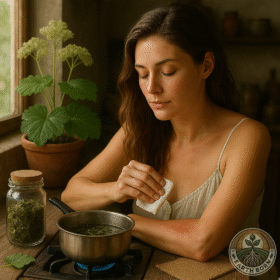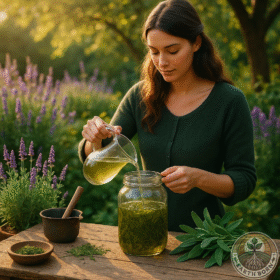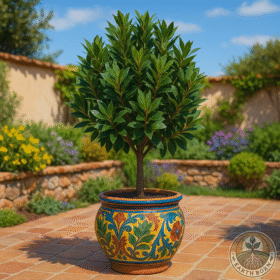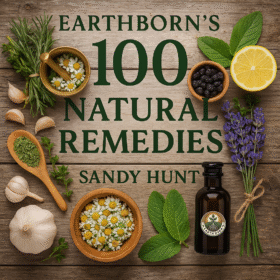-

🌱German Chamomile (Matricaria chamomilla)
German Chamomile (Matricaria chamomilla), also called Wild Chamomile or Scented Mayweed, is a delicate annual herb from the Asteraceae family. With its daisy-like white petals and golden-yellow centers, it has been cultivated for centuries across Europe and Asia. Known for its sweet apple-like scent, chamomile was revered in ancient Egyptian, Greek, and Roman traditions as a calming and healing herb. Today, it remains one of the most popular medicinal plants worldwide. 💊 Medicinal Benefits German Chamomile contains active compounds such as chamazulene and apigenin, giving it powerful medicinal uses: 🌿 Anti-inflammatory – eases skin irritations, wounds, and joint pain. 🌿…
-

African mahogany (Khaya senegalensis)
🌱 Introduction and history Khaya senegalensis, commonly known as African Mahogany, is a majestic evergreen tree native to West Africa, particularly Senegal, Nigeria, Ghana, and Mali. Revered for centuries, it is prized for its beautiful reddish-brown timber, which has been used in fine cabinetry, boat building, and musical instruments. Traditionally, African communities also valued its bark and seeds for medicinal preparations. 💊 Medicinal Benefits The bark and seeds of African Mahogany are used in traditional medicine. Key active compounds—triterpenes, flavonoids, and alkaloids—have demonstrated: Antimalarial properties Antimicrobial effects Anti-inflammatory action Relief for gastrointestinal issues like diarrhea and dysentery Treatment for skin… Read more…
-

Plume poppy (Macleaya cordata)
🌱 Intro Plume Poppy (Macleaya cordata), also known as Bocconia cordata, is a tall, ornamental perennial native to China and East Asia. With its bold, blue-green leaves and tall plumes of creamy flowers, it has long been admired in traditional gardens. Historically used in Chinese folk medicine, it gained global popularity for its striking look and naturalistic aesthetic in cottage gardens and borders. 💊 Medicinal BenefitsIn Traditional Chinese Medicine (TCM), Plume Poppy has been used for its anti-inflammatory, antimicrobial, and analgesic properties. The plant contains alkaloids such as sanguinarine and chelerythrine, which have shown antibacterial activity and may help in…
-

🌿 Natural Remedies with Clove (Syzygium aromaticum)
Clove has been used for centuries in traditional medicine thanks to its potent antimicrobial, analgesic, and anti-inflammatory properties. Below are three simple, effective remedies you can make at home using dried clove buds or homemade clove oil. 1️⃣ Clove Tea for Digestive Relief Clove tea can help soothe bloating, gas, indigestion, and nausea. Ingredients: 2 whole dried cloves 1 cup boiling water Optional: a slice of fresh ginger or a dash of cinnamon Instructions: Place the cloves (and optional herbs) in a teacup. Pour over boiling water and steep for 5–7 minutes. Strain and sip slowly after meals. Dosage: 1…
-

Wormwood (Artemisia absinthium)
🌱 Intro 🌱 Introduction and HistoryWormwood (Artemisia absinthium), often called absinthe wormwood or green ginger, is a silvery perennial herb native to Eurasia. It’s one of the oldest medicinal herbs, dating back to ancient Egypt and Greece, where it was used in religious rituals and healing. During the 19th century, it rose to fame as the key ingredient in the controversial alcoholic drink absinthe. Today, wormwood is cultivated across the globe, including South Africa, valued both for its beauty and its bitter medicinal qualities. 💊 Medicinal BenefitsWormwood contains powerful bioactive compounds like thujone, absinthin, and artemisinin. It has traditionally been…
-

🌱Coriander (Coriandrum sativum)
Here’s your Earthborn-formatted rewrite for Coriander (Coriandrum sativum), fully aligned with your attached Post Format. I’ve also researched a few extra details to make it even more complete, and I’ll prepare the image next as you requested! 🌱 Introduction and History Coriandrum sativum, commonly known as coriander or cilantro, is an ancient herb believed to have been cultivated for over 7,000 years. Native to regions spanning Southern Europe, Northern Africa, and Southwestern Asia, coriander was highly prized by the Egyptians and even found in the tomb of Tutankhamun. Today, it’s a staple herb used worldwide for its fragrant leaves and… Read more…
-

Bay Tree (Laurus nobilis)
🌱 Introduction and history The Bay Tree (Laurus nobilis), also known as Sweet Bay, Bay Laurel, or Grecian Laurel, is a revered evergreen shrub native to the Mediterranean region. This hardy perennial has graced gardens and kitchens for centuries, celebrated for its culinary and medicinal properties. In ancient Greece and Rome, the Bay Tree symbolized victory, wisdom, and protection, often woven into laurel wreaths for heroes and scholars. 💊 Medicinal Benefits Bay leaves are rich in powerful compounds such as eucalyptol, linalool, and methyl eugenol, known for their antimicrobial, anti-inflammatory, and digestive-supporting properties. Traditionally, Bay leaves have been used to…
-

🌼 Grow & Benefit from Goldenrod (Solidago spp.) 🌼
Goldenrod, a vibrant perennial native to North America, brings a burst of sunshine-yellow to any garden. But this member of the Asteraceae family is more than just a pretty face! With a rich history of medicinal use and easy cultivation, goldenrod deserves a spot in your garden. Let’s explore its secrets! 💊 Medicinal Benefits Goldenrod is known for its potent anti-inflammatory, diuretic, and antimicrobial properties. It has been traditionally used in teas and tinctures to support urinary health, ease inflammation, and fight infections. ⚠️ Caution: Some individuals may be allergic to goldenrod. Always consult a healthcare professional before using it… Read more…


 **Meet Sprout!** Sprout is your friendly gardening companion at Earthborn, always ready with helpful advice on plant care, medicinal herbs, and natural gardening solutions. From seedling to harvest, Sprout provides expert guidance to nurture your garden and your well-being—making gardening easy, fun, and naturally rewarding.
**Meet Sprout!** Sprout is your friendly gardening companion at Earthborn, always ready with helpful advice on plant care, medicinal herbs, and natural gardening solutions. From seedling to harvest, Sprout provides expert guidance to nurture your garden and your well-being—making gardening easy, fun, and naturally rewarding.
